I always look forward to harvesting potatoes in the fall. It is like finding buried treasure. With all the colors and varieties I like to plant, my potatoes are like easter eggs.
The taste of a home grown potato can’t be beat. This is an easy crop for you to grow, even if you don’t have great soil, a lot of time, or even a lot of space.
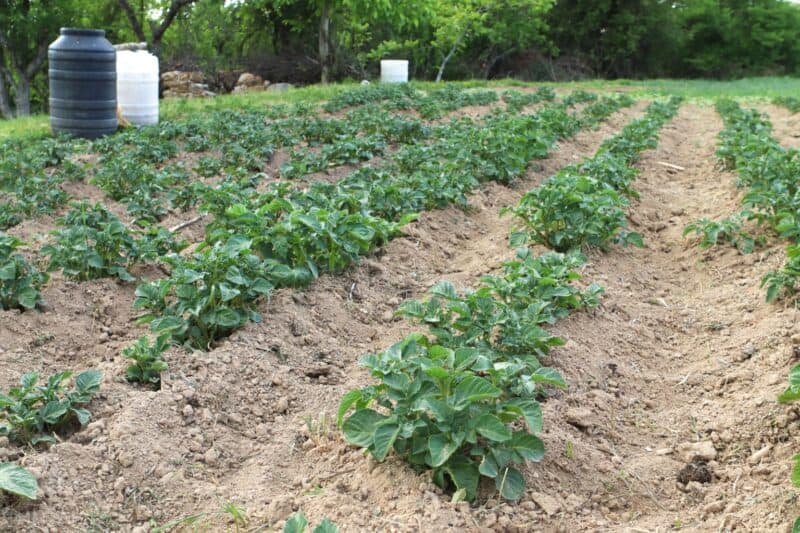
It’s also a great “survival crop”, because it is easy to grow, the yields can be substantial, and it is a staple in our diet – so the chances of everyone in your family loving it are high.
Sometimes I am gone commercial fishing for a big chunk of the summer, or really busy with other projects. No matter what else is going on in my life, I always throw at least a few potatoes into the ground.
Why Grow Potatoes?
Better Taste
There is a huge difference in taste and texture between home grown and store bought potatoes. Conventional potatoes have been bred for a high yield per acre and uniform shape.
The flavor has suffered as a result. Potatoes from the store are much more bland and mealy.
I used to drown potatoes in butter and salt. However, my own home grown potatoes have such a rich flavor and texture, I use much less salt and skip the butter. You could see this as a health benefit, if you are trying to cut down on sodium and fat.
Better For Your Health
According to Jo Robinson’s landmark work “Eating on the Wild Side,” modern varieties of potatoes such as Russets and Yukon Golds are high glycemic.
This means the sugar in them is digested so quickly it causes a spike in blood sugar. This is a no-no for people with diabetes, or those at risk of developing it.
If you grow your own potatoes, you can grow varieties with a lower glycemic index such as purple potatoes. Of course, if you have diabetes you should consult a doctor about anything in your diet.
Robinson also explains that conventional potatoes are low in nutrients compared to heirloom varieties.
Furthermore, conventional potatoes are consistently ranked in the “Dirty Dozen:” the twelve conventionally grown foods that have the most pesticide exposure.
Easy and Efficient
Potatoes are originally from the mountains of South America, where the soil is not so great. This is good news for you if you are still building and developing your soil.
Potatoes can handle a lot of neglect. If you tend to come and go during the summer, or if you are busy with other projects, these are a great choice for you.
Potatoes are commonly grown vertically. Even if you have a small amount of space you can still grow a lot of potatoes.
Fun!
Digging for potatoes is fun! I usually plant a hodgepodge of varieties, so it is extra fun when I don’t know what color potato I have until I pull it out.
Of course, if you have back problems, or aren’t in your youth years anymore, you might want to consider alternative ways to grow them.
One cheap and easy way is to grow potatoes in buckets – which you can place higher up above ground level so you don’t have to bend tending for the plants.
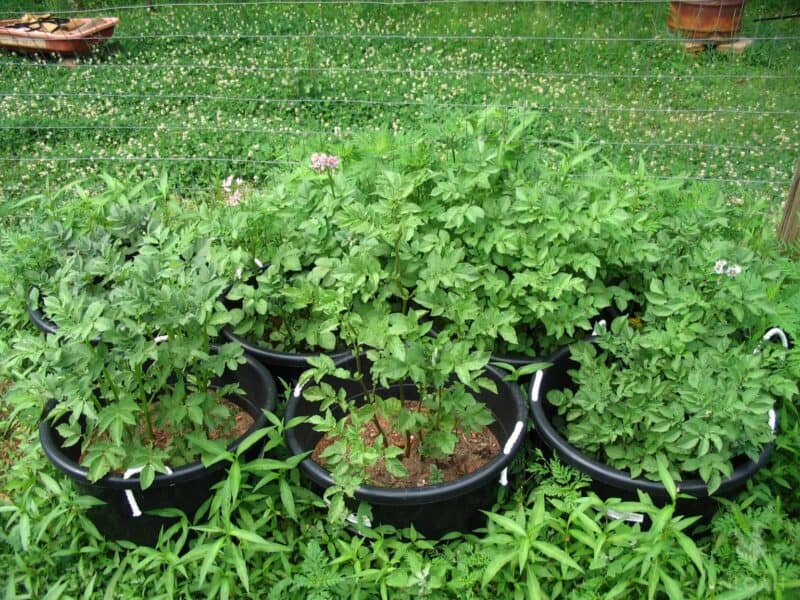
Harvesting potatoes is a great way to get into the garden with children and grandchildren. They will not tire of this game. It really is exciting when you reach blindly into the earth, and then you find something!
Choose Your Seed Potatoes Wisely
Remember the potato famine? Potatoes are sensitive to diseases in the soil. Those diseases can spread if you transplant potatoes from contaminated soil. It is best to be very wary about where your seed potatoes come from.
Talk to your local cooperative extension about what diseases are present in your region, and how to make sure you do not inadvertently spread them.
No matter where you obtain your seed potatoes, it is a good idea to get them early. This will give you time to sprout them (See later in the article). Also, many suppliers sell out of popular varieties.
Grocery Store Potatoes
I am Jewish, and I always laugh at an old joke my rabbi told. How many Synagogues does a Jew on a desert island need? The answer is two: One to pray in and one he’d never set foot in.
Gardening advice can be the same way. I personally would never plant potatoes from the grocery store. That being said, there are many people out there who do plant grocery store potatoes and have a great time doing it.
With this caveat in mind, I’ll tell you why I don’t plant potatoes from the store. They may have been exposed to diseases. They may have been treated with chemicals to prevent them from growing into new potatoes.
Also, one of the biggest advantages to growing potatoes is the ability to grow healthier and better tasting varieties. This is lost if you just plant russets from the store.
Potatoes From Your Neighborhood
I have had the best luck with potatoes from a trusted neighbor who saved potatoes from his previous crop.
Planting varieties that your neighbors have had success with is a great idea, since your climate and soil are likely to be similar. Of course, you need to be sure your neighbors haven’t experienced any soil diseases.
Depending on your climate it can be tough to hold on to potatoes all year. However, if you do manage to keep a few through the winter to chit for yourself that’s great. There are additional tips on saving potatoes later in this article.
Eventually, if you save potatoes year after year, you may notice a decline in yield. This is normal. It’s time to start fresh with new seed potatoes.
Seed Potatoes from Seed Suppliers
Seed suppliers carry a wide variety of potatoes for the home grower. They also generally have excellent customer service. If you are not sure which variety is right for you, they can be very helpful.
One problem I have is that the minimum order from many national seed suppliers is one pound. If you would like to plant more than one variety, and you have to purchase a pound of each, this adds up to a lot of potatoes.
More potatoes than I, as a single lady, need. This is not a problem for you if you do plan to plant a LOT of potatoes.
Another problem I have with purchasing potatoes from a seed supplier is my climate. I live in Alaska, where it’s very cold. If I want my seed potatoes to arrive in time for me to sprout, or “chit” them, they may be frozen and damaged in shipping. I’m also the last one to the party.
Many varieties are sold out by the time I want to order potatoes. If you live in a more temperate climate, these are less likely to be issues for you.
Local Nurseries are Great for Home Growers
When I do have to purchase seed potatoes, I prefer to go directly to a local nursery. They typically allow customers to purchase as many (or as few) as they need.
If I see a variety I’ve never tried before, I might even buy just one potato and see how it does. I come out of the nursery with a medium sized bag filled with many varieties.
Local nurseries also have the advantage of being, well, local. The potatoes they carry are likely to be appropriate to the local climate and other growing conditions. The people working there typically can provide excellent advice when you tell them the details of your growing situation.
If you go to a local nursery, it is a good idea to go early. They often sell out of seed potatoes. Also, it is good to give yourself time to chit your potatoes at home. This can take a couple of weeks.
Cutting Eyes vs Whole Potatoes
Most of us know that every eye on a potato has the potential to grow into a new plant. However, your plants will have an advantage if you use a single potato.
The whole potatoes give the plant more of a nutritional bonus to begin with. The cut potatoes are also more sensitive to pests and rot. This risk can be mitigated if you let the cut pieces dry thoroughly before planting.
Most of this comes down to scale. I don’t grow acres of potatoes. I grow a few containers.
The cost savings for me of cutting potatoes up is negligible. If you are growing on a larger scale, cutting up your potatoes makes more sense.
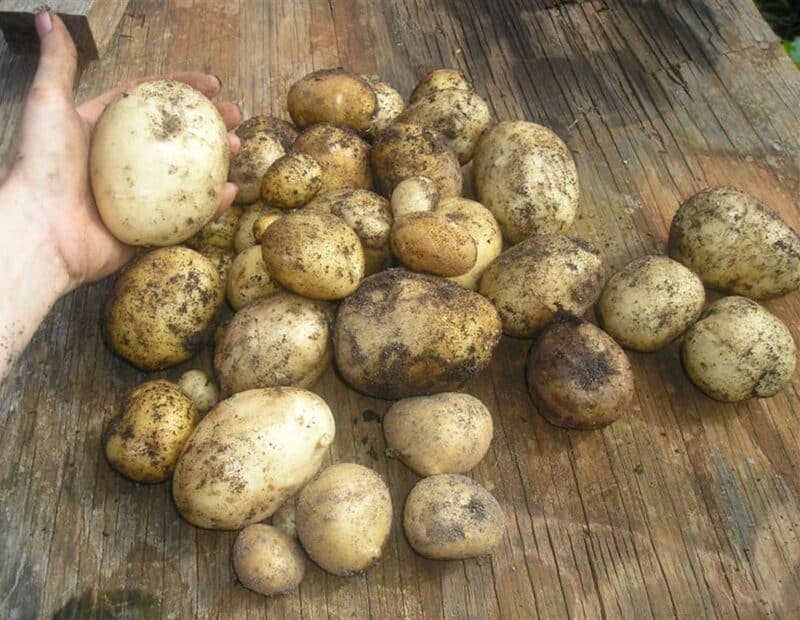
Prepare Your Site
One of my early gardening teachers gave me a great gift. I wanted to make sure I did everything “right,” and I was always full of questions.
I wrote down everything she said. Finally, she told me, “Plants want to grow. Give them the basics. Everything else is just percentages.”
Potatoes are very hardy. The guidelines below are meant to be just guidelines.
Potatoes need potassium and if you put a great effort into fertilizing and watering, you will have a bigger yield. However, if other priorities tear you away for part of the summer, your potatoes will be just fine.
Potatoes like full sun and loose, well drained soil. If your soil feels hard and compact, till it well. If the grain is really fine, consider amendments such as peat.
I mix lichens, leaves, seaweed, and moss into the soil for my potatoes. Grass clippings are another great addition if you have access to them.
Decide whether you want to plant your potatoes directly into the ground or use a vertical planter.
In order to minimize diseases in your potatoes, crop rotation is very important.
If you plant in the ground, plant in a different spot every year. If you use containers, transfer the soil to elsewhere in the garden after harvest.
Potatoes like full sun.
Whatever planter design you choose, it is best to make it possible to dump it out at the end of the season.
This makes it easy to transfer your soil to another part of the garden, for crop rotation purposes. It also makes it much easier to harvest the potatoes.
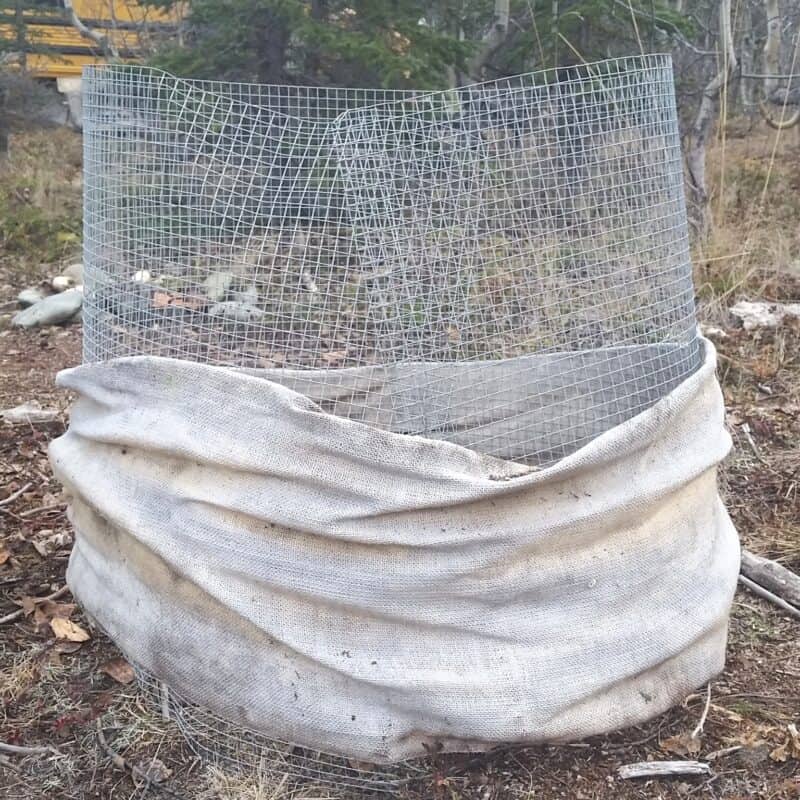
Vertical Planters
Many growers construct vertical planters for their potatoes. These have the advantage of saving space while still growing a great harvest. As your potato plants grow, you layer additional soil into your planter.
If you are artistic, you can really unleash your creativity on your potato planter. Any colors or materials are fair game.
This is a great opportunity to upcycle as well. A quick look on Pinterest will lead you to hundreds of beautiful planters people have made.
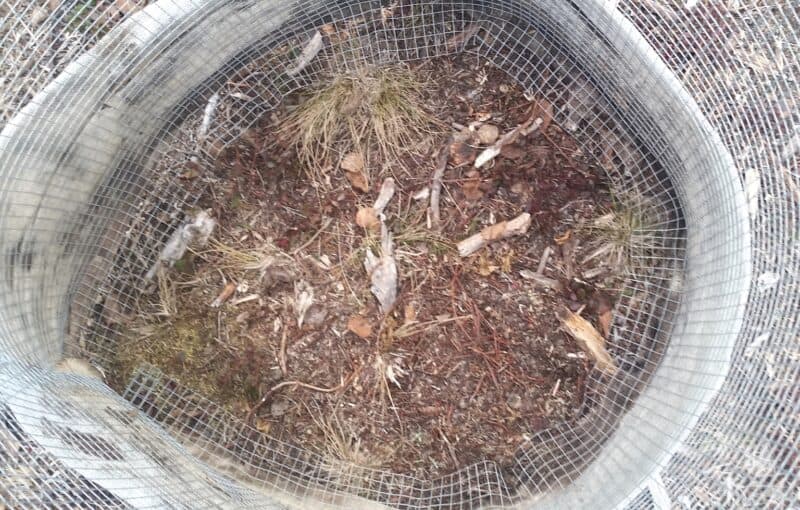
My planters are not particularly beautiful. However, they have advantages:
- Minutes to make
- Great drainage
- Keep out the varmints!
To make a super easy planter:
- Bend chicken wire or hardware cloth into a cylinder.
- Weave the ends together with a piece of wire.
- Tuck the bottom few inches inwards to form a horizontal shelf inside the cylinder.
- Cover the shelf with large rocks.
- Wrap the bottom with layers of burlap or fabric to prevent light from penetrating the soil.
- Fill with soil!
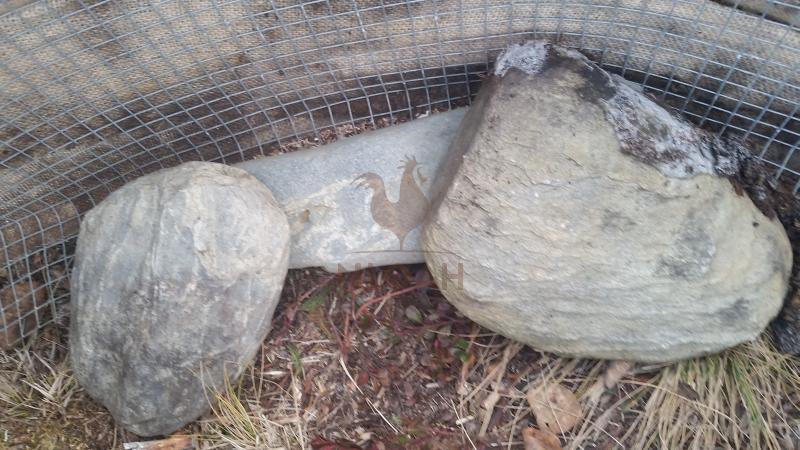
Plant your Potatoes
The earlier you get your potatoes into the ground, the better your yield will be. As soon as you can into the ground, it’s time to plant. Potatoes will survive a light frost.
The Traditional Method
Bury potatoes about three inches. If you use cut pieces of potatoes, place them in the ground with the eyes facing up.
Plant potatoes about a foot apart from each other. If you are going to dig some up early for fingerlings, you can plant closer.
If you are planting in the ground, make your rows wider apart than you think: at least 3’. This will give you a lot of space and soil for mounding:
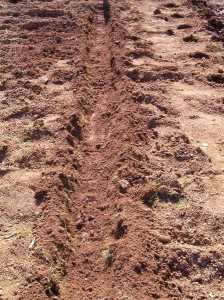
Next we placed the potatoes in the trench, cut side down and eye side up, 12-18″ apart:
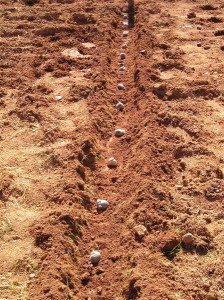
Once they were all in place, we covered the trench back over with dirt, and watered it. I used wooden stakes to mark the rows:
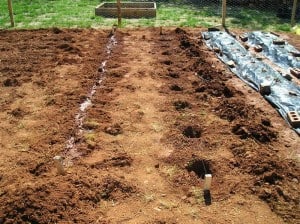
The Deep Hole Method
The first row I planted was using a deep hole method. It’s easy to learn how to use a posthole digger, which is what I used to dig 10 holes 12″ deep, spacing them 12-18″ apart:
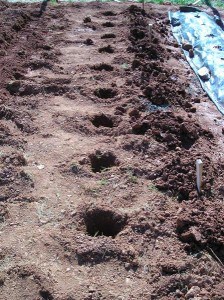
You’re supposed to put 2″ of compost in the bottom of the hole, but I didn’t have any, so I didn’t put anything.
The theory is that if you dig a deep hole, and just fill it in a little every time the plant starts growing up, it will save time and effort in the long run.
Once the holes were dug, we placed a seed into each. Once they were all in, we covered them over with 2″ of dirt and watered them.
Lastly, you can also grow potatoes in raised beds:
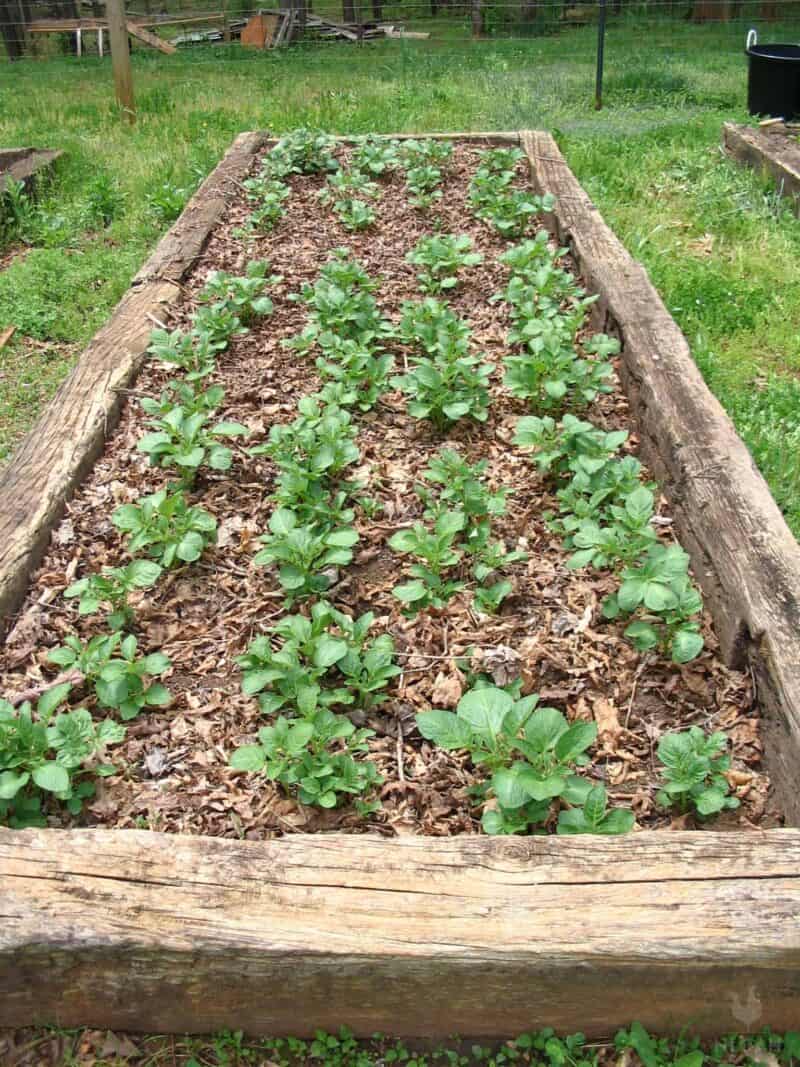
Mounding
Water your potatoes well.
You can be irresponsible about watering and fertilizing your potatoes. However, you will definitely lose out if you don’t mound.
Mounding is the key to getting a good yield from each plant. As the potato plants grow taller, bury the stems. Potatoes will then grow in the newly mounded area. You can add compost as you are mounding to give the potatoes a nutritional boost. Seaweed is a nice additive, as well (see fertilizing).
In vertically planted potatoes, carefully add soil and any other materials around the plants. If you planted into the ground, gently rake soil towards your rows of potatoes.
This is a good activity for SOME children. If you are not gentle, you can damage the plants.
Fertilizing
Adding compost to the soil initially and as you are mounding is a great way to fertilize your potatoes. Compost is also very pH neutral, which is great. Avoid using too much fertilizer that will make your soil alkaline, as potatoes like either neutral or slightly acidic soil.
Coastal dwellers often layer seaweed directly into their potato mounds. This fertilizes the plants and also provides extra material for mounding.
Johnny’s Seed Supplier also recommends using a foliar spray such as fish emulsion a few times during the growing season. Fish sprays can attract predatory animals and local dogs. Whether to use these or not depends on your neighborhood.
Potatoes evolved in mountains that did not have very fertile soil. More fertilization will get you more potatoes. The potatoes will probably be bigger, as well. However, if you don’t use a whole lot of fertilizer you can still expect a modest crop.
Watering
Potatoes are much more sensitive to overwatering than under watering. If they are in soil that is too wet, they can rot. If you live in a very wet climate, row covering can protect the plants from getting deluged.
In climates with a natural alternation between sun and rain you can let nature take its course without paying too much attention to watering. This is especially true if you mulch around the plants after they emerge, and after mounding.
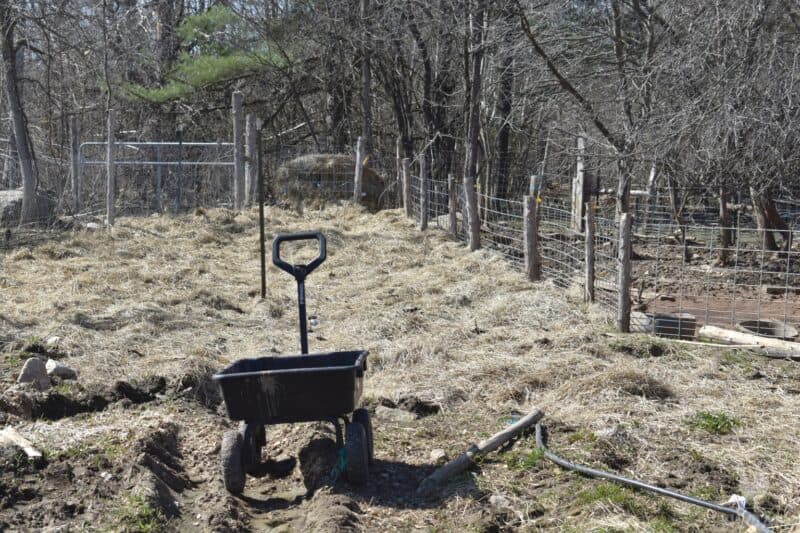
If you do live in a drier climate you may have to water. Pay special attention to keeping your potato plants watered during and immediately after flowering. This will help to promote the most growth.
It is very important to stop watering the aboveground portion of your potato plant withers and dies. Your potatoes will remain in the ground for two more weeks, and it is best if they are dry.
Pest Control
Some bugs just love to eat potato leaves! Row covering can deter many flying pests. Search under the leaves of your plants for insect eggs. Crush and remove these as you find them.
If you live in slug or snail country, these pests will really go after potatoes.
The best remedy I have ever seen for a snail infestation is ducks. If you or your neighbors don’t have any ducks handy, manual removal is probably second best. You will catch the most of them if you go out at night with a headlamp. The snails are most active then.
There are a variety of slug traps that people swear by. I have been most impressed with beer. One homesteader I know asks her local bartender for the beer that has swilled into the catch tray in the keg area. That way she is recycling what would otherwise be trash, and she can drink the fresh beer for herself!
Even with traps, you still have to pick slugs off. The best times to go after slugs are early morning and early evening.
Harvesting
You can harvest early potatoes from the sides of your potato mound by gently searching for them. This process has a few nicknames; my favorite is “scrabbling.”
This is a time honored tradition and it will not hurt the rest of the plant. You can expect to find young potatoes to harvest as soon as two or three weeks after flowering.
Your potatoes will store better if you wait to harvest the bulk of them until two weeks after the foliage has died back.
Note the date the foliage has died in your calendar to help you keep your timing right. This waiting period helps the potatoes to “set skin.” Remember, during this time you should not water your potatoes.
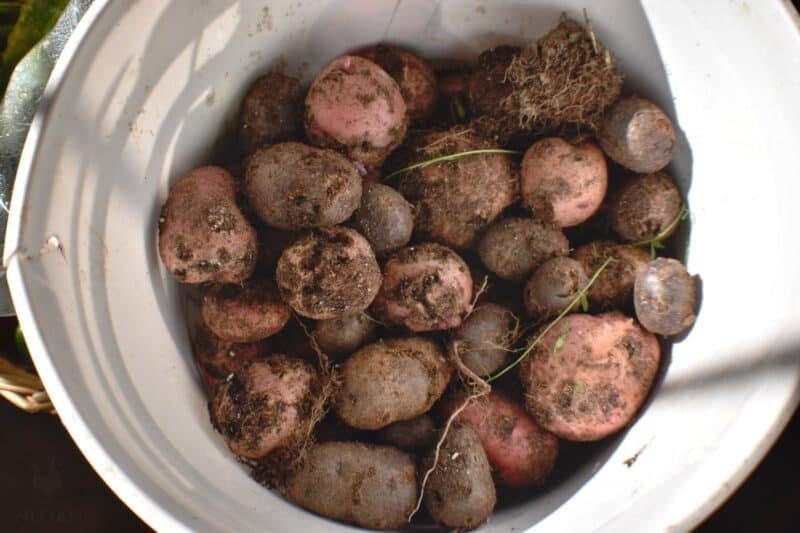
You do not want your potatoes to freeze close to harvest time. If you have to “break the rules” a little on the two week time table, that is better than losing your whole crop. Just know that they may not store quite as well, and try to eat them sooner rather than later.
You can cut down the green plants before they die naturally. This could be a good move if your plants look green and vigorous, but you know that it will likely freeze soon.
Harvesting potatoes is really fun for the whole family. However, it is important to dig carefully. If you break the skin of a potato, it will not store as well. I usually feel around more with my hands than any other tool.
Small vertical containers can simply be dumped out! Then you just sift through the pile looking for your precious potatoes.
It is good to dump the containers anyway, because you can transfer the soil to another part of your garden. If you grow a different crop in that soil next year, you minimize the likelihood of breeding potato diseases.
Storage
Do not wash potatoes you wish to store. Before putting the potatoes in long term storage, they need to cure for a week. Spread them out in a dark, dry place that is 65-70 degrees F.
If you don’t have that kind of space in your own homestead, try trading some potatoes for the use of someone’s heated garage. This will work out well for everyone!
Once the potatoes are dry, transfer them to a cool (35-40 degrees F), dark place. Remember, light will make them sprout so darkness is important. At this stage in the game, it is OK for the potatoes to be in a humid environment. Don’t worry if you use a root cellar and it gets a little bit damp in there.
Try to save a few potatoes for next year. The potatoes you save should be among the biggest. They are likely to grow the most successful plants next year.
Enjoy Your Potatoes!
Potatoes are a fun, rewarding, and easy crop to grow. Home grown potatoes are good for your health and unbelievably delicious. With some minimal preparation and care, you can have a great harvest. Good luck to your potato patch and all of your gardening endeavors!
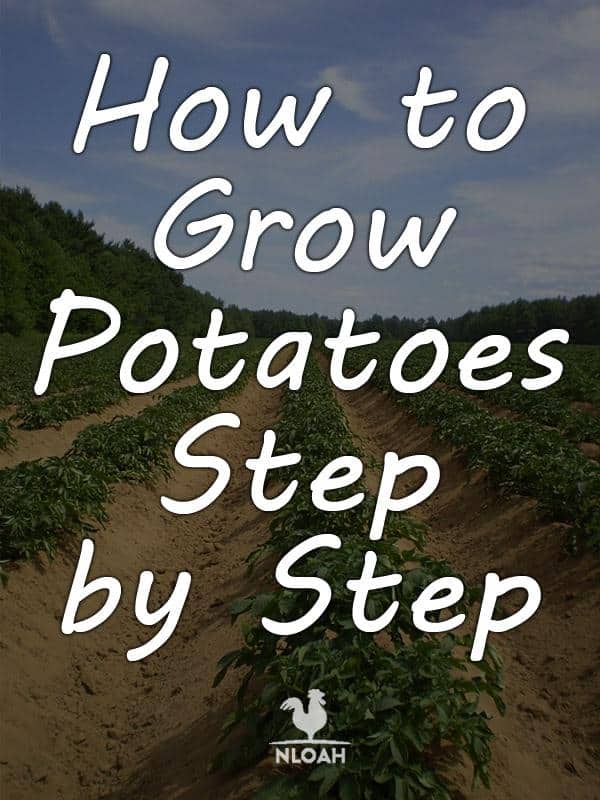

Allison Sayer lives in a schoolbus on an off-grid property in the Alaskan Copper Valley. She has been part of many amazing projects. These include cooking at a remote nature center, managing a multi-family hoop house, volunteering at a chicken sanctuary, and WWOOFing on a small farm. Through her deep friendships throughout the Alaskan wilderness, she has helped many friends develop their homes and dreams. Allison is currently building up her property with the goal of starting her own microgreen farm.

I can’t get rid of potatoes. Thank goodness I only planted them in one place or there would be potatoes everywhere in my garden, because I have potatoes every year and don’t even plant them..
Seems when I think I’ve gotten out every single potato that I can find and take them out, there must a few tiny seeds left behind because every early spring I have potatoes coming up in rows as if I’d planted. Lol. I do a no dig no till garden. Its a win win situation but I wont be planting any in other places or I’d have them everywhere.
Thank you 😊
Love it will be planting potatoes in zone nine central Florida .Good Gardening!
I used to put out saucers of beer to catch slugs – never caught a one. However the saucers would be empty every morning. Turns out my dog had a drinking problem.
I am sitting on a Saturday reading about growing potatoes. having done it many times when young. I am no longer young ! While I have done many things I find I learn something new each day. please keep the articles coming. I fear what will happen as I finish the last page.
Grampa
I’ll make sure the articles continue to come no matter what 🙂